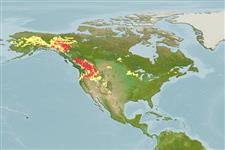Classification / Names
Common names | Synonyms | Catalog of Fishes (gen., sp.) | ITIS | CoL | WoRMS | Cloffa
Actinopterygii (ray-finned fishes) >
Cypriniformes (Carps) >
Catostomidae (Suckers) > Catostominae
Etymology: Catostomus: Greek, kata = down + Greek, stoma = mouth (Ref. 45335); macrocheilus: macrocheilus meaning large lip (Ref. 1998). More on author: Girard.
Environment / Climate / Range
Ecology
Freshwater; demersal; depth range 1 - 80 m (Ref. 1998). Temperate, preferred ?; 54°N - 41°N
North America: Arctic basin in Canada from Peace River drainage in British Columbia to Smokey River drainage in Alberta; Pacific Slope from Nass River in British Columbia to Snake River drainage (below Shoshone Falls) in Idaho and Nevada, USA, and Coquille River in Oregon, USA.
Size / Weight / Age
Maturity: Lm ? range ? - ? cm
Max length : 61.0 cm TL male/unsexed; (Ref. 5723); common length : 25.0 cm TL male/unsexed; (Ref. 12193); max. reported age: 15 years (Ref. 12193)
Occurs in pools and runs of medium to large rivers. Also found in lakes. Pelagic up to 1.8 cm in length (Ref. 1998). Young feed on planktonic cladocerans, copepods, ostracods, and mites; chironomid, trichopteran and ephemeropteran larvae; and bottom ooze (Ref. 1998). Adults feed on algae, diatoms, insects, amphipods, and mollusks (Ref. 1998). May feed on salmonid eggs (Ref. 1998). Preyed upon by mergansers, osprey, eagles, and bears (Ref. 1998). Edible but not highly favored (Ref. 1998).
Life cycle and mating behavior
Maturity | Reproduction | Spawning | Eggs | Fecundity | Larvae
Page, L.M. and B.M. Burr, 1991. A field guide to freshwater fishes of North America north of Mexico. Houghton Mifflin Company, Boston. 432 p. (Ref. 5723)
IUCN Red List Status (Ref. 115185)
CITES (Ref. 94142)
Not Evaluated
Threat to humans
Harmless
Human uses
Fisheries: commercial; aquarium: public aquariums
More information
ReferencesAquacultureAquaculture profileStrainsGeneticsAllele frequenciesHeritabilityDiseasesProcessingMass conversion
Tools
Special reports
Download XML
Internet sources
